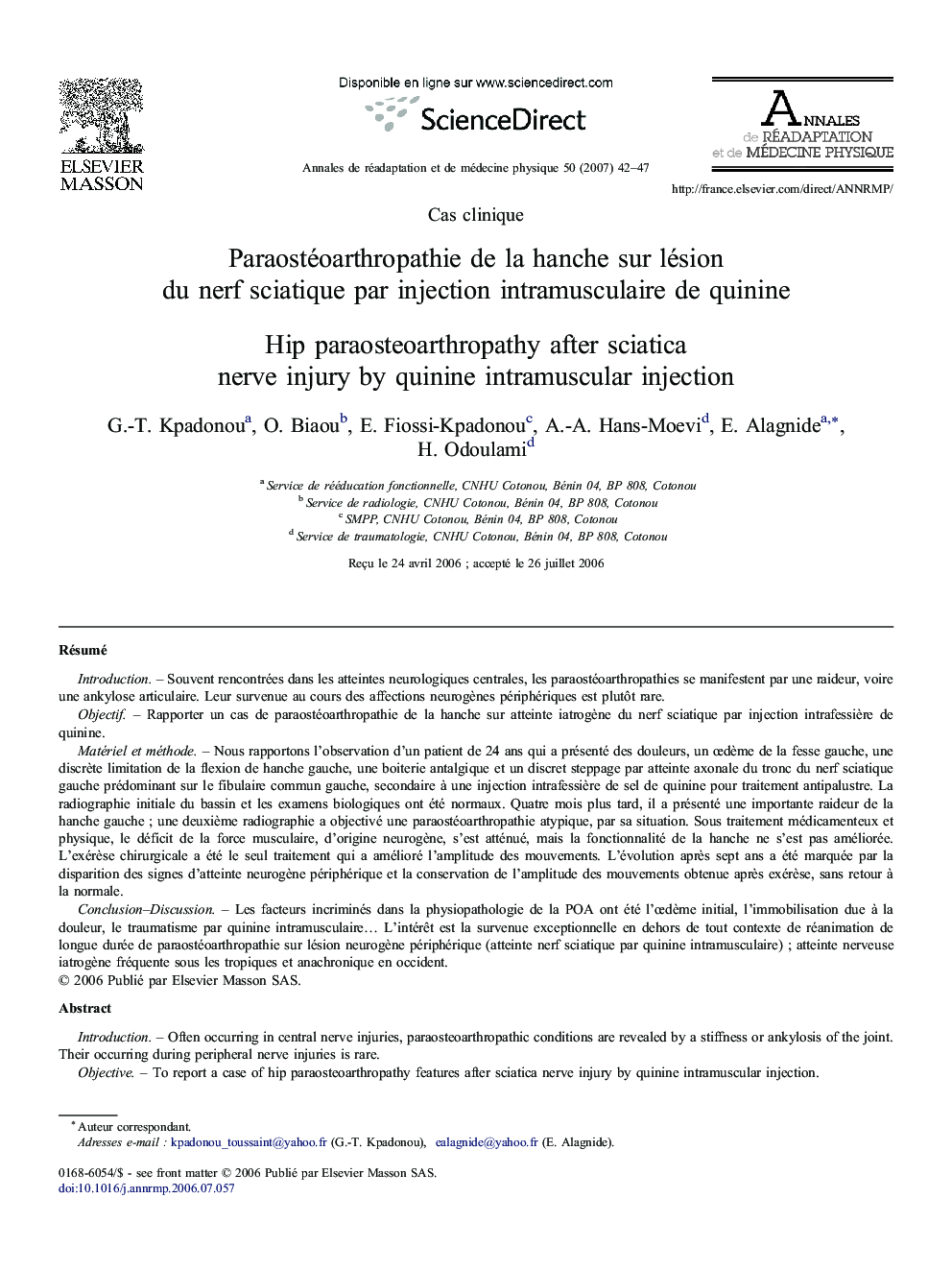| کد مقاله | کد نشریه | سال انتشار | مقاله انگلیسی | نسخه تمام متن |
|---|---|---|---|---|
| 4040281 | 1264297 | 2007 | 6 صفحه PDF | دانلود رایگان |

RésuméIntroductionSouvent rencontrées dans les atteintes neurologiques centrales, les paraostéoarthropathies se manifestent par une raideur, voire une ankylose articulaire. Leur survenue au cours des affections neurogènes périphériques est plutôt rare.ObjectifRapporter un cas de paraostéoarthropathie de la hanche sur atteinte iatrogène du nerf sciatique par injection intrafessière de quinine.Matériel et méthodeNous rapportons l'observation d'un patient de 24 ans qui a présenté des douleurs, un œdème de la fesse gauche, une discrète limitation de la flexion de hanche gauche, une boiterie antalgique et un discret steppage par atteinte axonale du tronc du nerf sciatique gauche prédominant sur le fibulaire commun gauche, secondaire à une injection intrafessière de sel de quinine pour traitement antipalustre. La radiographie initiale du bassin et les examens biologiques ont été normaux. Quatre mois plus tard, il a présenté une importante raideur de la hanche gauche ; une deuxième radiographie a objectivé une paraostéoarthropathie atypique, par sa situation. Sous traitement médicamenteux et physique, le déficit de la force musculaire, d'origine neurogène, s'est atténué, mais la fonctionnalité de la hanche ne s'est pas améliorée. L'exérèse chirurgicale a été le seul traitement qui a amélioré l'amplitude des mouvements. L'évolution après sept ans a été marquée par la disparition des signes d'atteinte neurogène périphérique et la conservation de l'amplitude des mouvements obtenue après exérèse, sans retour à la normale.Conclusion–DiscussionLes facteurs incriminés dans la physiopathologie de la POA ont été l'œdème initial, l'immobilisation due à la douleur, le traumatisme par quinine intramusculaire… L'intérêt est la survenue exceptionnelle en dehors de tout contexte de réanimation de longue durée de paraostéoarthropathie sur lésion neurogène périphérique (atteinte nerf sciatique par quinine intramusculaire) ; atteinte nerveuse iatrogène fréquente sous les tropiques et anachronique en occident.
IntroductionOften occurring in central nerve injuries, paraosteoarthropathic conditions are revealed by a stiffness or ankylosis of the joint. Their occurring during peripheral nerve injuries is rare.ObjectiveTo report a case of hip paraosteoarthropathy features after sciatica nerve injury by quinine intramuscular injection.Materials and methodWe report a case of a 24-year-old patient presenting with pain, oedema of the left buttock, limitation of bending of the left hip, and antalgic limping associated with a small step because of axonal left sciatic nerve injury. Initial pelvis X-ray and laboratory findings were normal. Reviewed 4 months later with important stiffness of the left hip, a second X-ray showed an atypical paraosteoarthropathy (POA). Chemotherapy and physiotherapy alleviated neurological muscle weakness but did not have any effect on the hip functionality. Surgical excision was the only treatment that improved the amplitude of movements. Evolution 7 years later showed the disappearance of the peripheral nerve-injury signs and the conservation of the movement amplitude obtained after excision, without a return to normal.Conclusion–DiscussionFactors pointing to this POA were initial œdema, immobilization because of pain, and trauma by quinine intramuscular injection. The interest is the exceptional occurrance of POA on a peripheral nerve injury (sciatica nerve injury by quinine injection) outside the context of length resuscitation and that sciatica nerve injury is frequent in tropical countries but anachronistic in a developed one.
Journal: Annales de Réadaptation et de Médecine Physique - Volume 50, Issue 1, January 2007, Pages 42–47